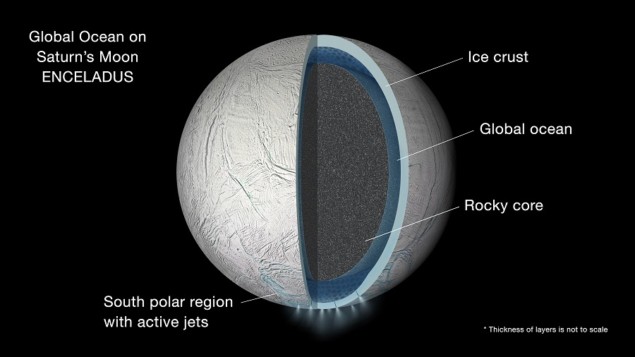
Tidal heating could power Saturn’s moon Enceladus for tens of millions to billions of years if its core is porous and unconsolidated, a new model suggests. The conclusion is based on 3D simulations of tidal friction and heat transport, in which energy is transmitted from the core to the ice shell by advection. As well as accounting for the unexpectedly high heat flux in Enceladus, the model also explains differences in ice thickness between the poles and the equator, and the presence of hydrothermal products in the moon’s water plumes.
Surprisingly warm
Evidence for liquid water under the frozen surface of Enceladus began to mount after the Cassini spacecraft’s first flybys of the remarkable moon in 2005. Further observations suggested that a global ocean separates the moon’s rocky core from its icy shell, but radioactive decay and tidal heating seemed insufficient to explain its persistence.
Writing in Nature Astronomy, Gaël Choblet of the Laboratoire de Planétologie et Géodynamique in Nantes and collaborators in France, USA, the Czech Republic and Germany, have shown that orbital interactions with another of Saturn’s moons, Dione, could generate enough tidal friction within Enceladus to sustain the ocean, but only if the porosity and permeability of the moon’s core fall within certain ranges. Although the body’s small size has made its anomalous warmth difficult to explain until now, it also means that such porosity could have been present in the core since the moon’s formation.
Thin ice
For some combinations of parameters, the group’s simulations predicted polar upwellings of water warmed in the core, where rock and hot water can interact, and corresponding downward flows of cooler water elsewhere. This result is consistent with observations suggesting that the ice is significantly thinner at the poles than at the equator, but it does not explain the asymmetry between the south pole, where the characteristic “tiger stripes” jet plumes of water, and the north pole, which is ancient and inactive. Choblet and colleagues suggest that a small discrepancy in ice behaviour between the poles could have been amplified over time by the concentration of tidal friction in fractures at the south pole.



